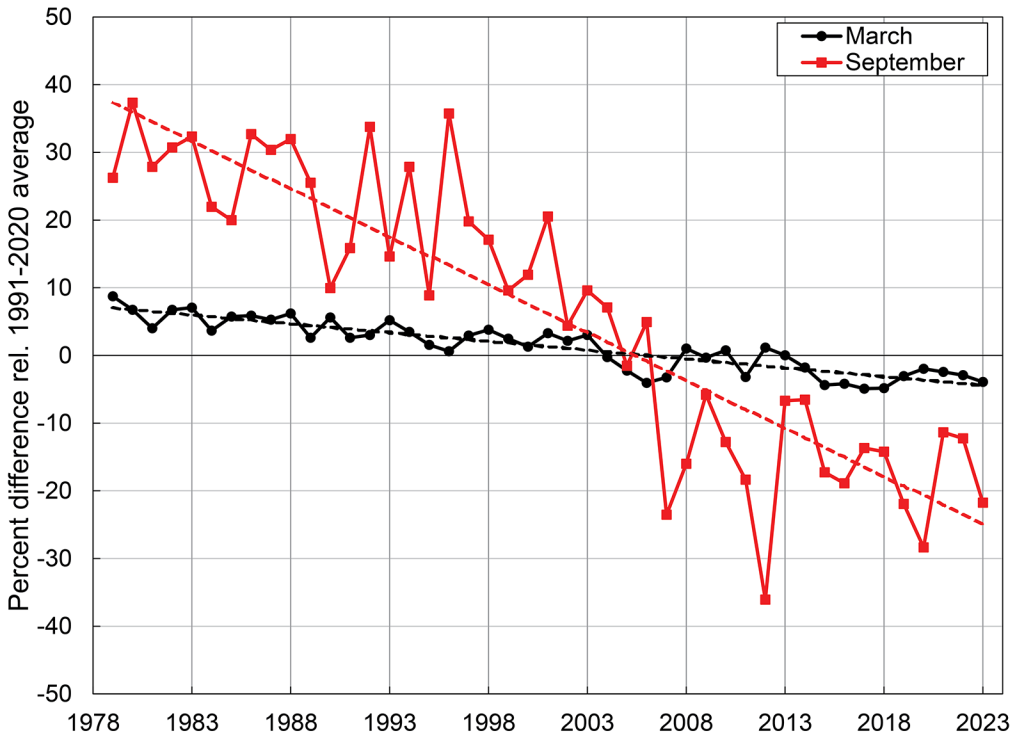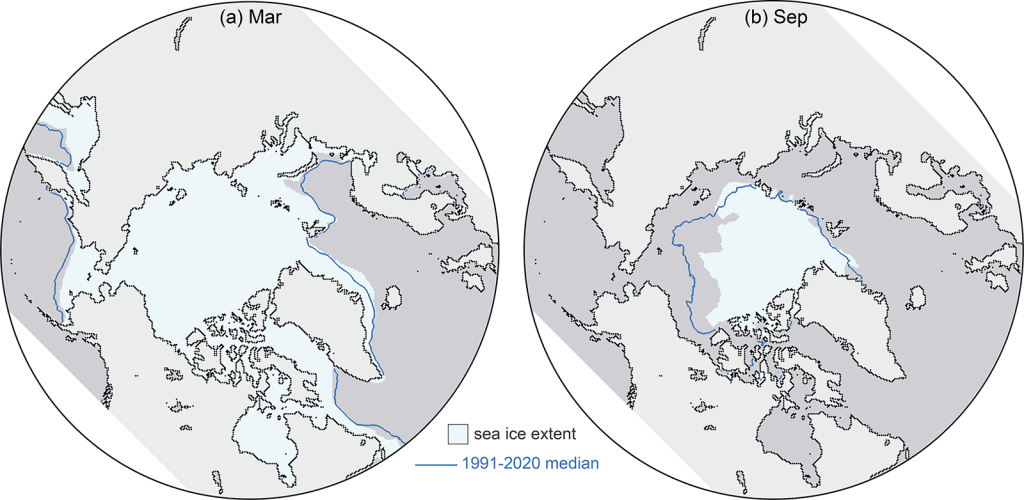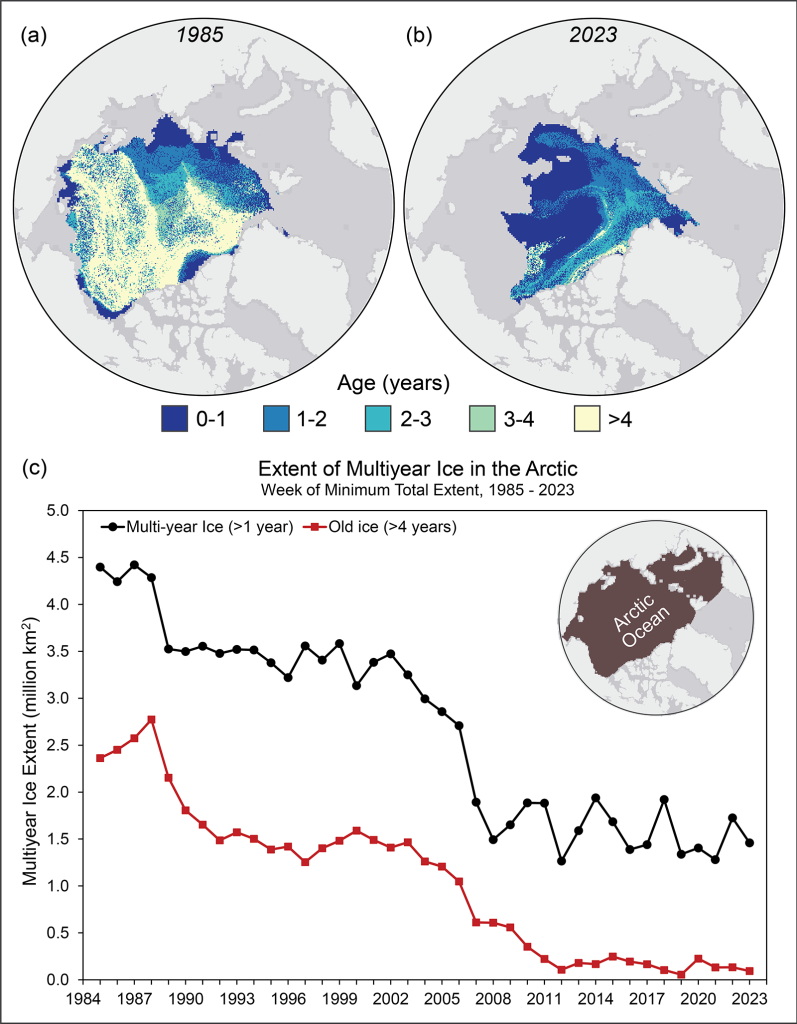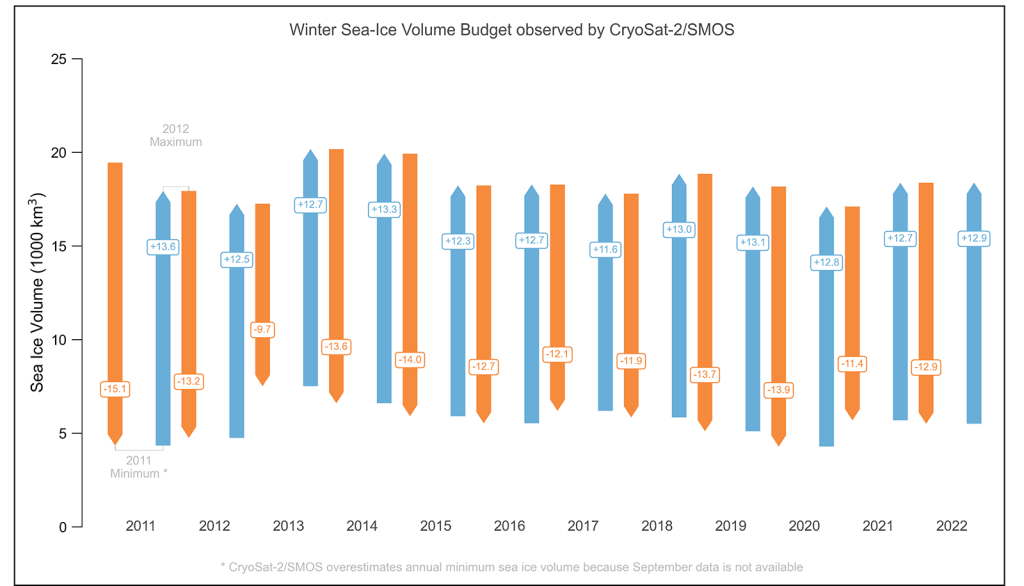W. N. Meier1, A. Petty2, S. Hendricks3, L. Kaleschke3, D. Divine4, S. Farrell5, S. Gerland4, D. Perovich6, R. Ricker7, X. Tian-Kunze3, and M. Webster8
1National Snow and Ice Data Center, Cooperative Institute for Research in Environmental Sciences, University of Colorado Boulder, Boulder, CO, USA
2Earth System Science Interdisciplinary Center, University of Maryland, College Park, MD, USA
3Alfred Wegener Institute, Helmholtz Centre for Polar and Marine Research, Bremerhaven, Germany
4Norwegian Polar Institute, Fram Centre, Tromsø, Norway
5Department of Geographical Sciences, University of Maryland, College Park, MD, USA
6Thayer School of Engineering, Dartmouth College, Hanover, NH, USA
7NORCE Norwegian Research Centre, Tromsø, Norway
8Polar Science Center, Applied Physics Laboratory, University of Washington, Seattle, WA, USA
Headlines
- Sea ice extent was 6th lowest in the satellite record (1979 to present) and downward trends continue; the last 17 September extents (2007-23) are the 17 lowest in the record.
- The amount of multiyear ice was largely unchanged from 2022, as multiyear extent remained far lower than in the 1980s, with minimal old ice (>4 years old).
- Average sea ice thickness for the 2022/23 winter was lower than the previous winter, near the 2011-23 average; volume at the end of the 2022/23 winter was the same as the previous year.
Introduction
Arctic sea ice is the frozen interface between the ocean and the atmosphere. It reduces the absorption of solar energy because of its high albedo relative to the darker open ocean surface. In addition, as a physical barrier, it modifies the heat and moisture transfer between the atmosphere and ocean. Sea ice plays a key role in the ecosystem, providing an essential habitat for marine life and modulating the biogeochemical balance of the Arctic. The sea ice cover has long played a practical and cultural role in Indigenous communities of the north. Sea ice historically limited national and corporate activities in the Arctic, but decreased ice cover is influencing commercial transportation, resource extraction, and national security.
The winter 2022/23 freeze-up was typical of recent years with sea ice growth rates near average while the areal coverage remained in the lowest 10% extent (below the lower interdecile range) through the year. Ice growth was particularly slow in the Barents and Kara Seas as well as in the Chukchi Sea, but near normal in other regions. Winter near-surface air temperatures were higher than the 1991-2020 average over most of the Arctic Ocean, particularly in the Barents Sea and portions of the Beaufort Sea (see essay Surface Air Temperature). However, lower temperatures prevailed over much of the Eurasian side of the Arctic during spring. Summer temperatures were mixed, with higher-than-average temperatures over the Barents, Kara, Beaufort, and Chukchi Seas and average or slightly below average temperatures elsewhere.
Sea ice extent
One of the most commonly used indicators of long-term Arctic sea ice conditions is sea ice extent, which is defined as the total area covered by ice of at least 15% concentration. The primary source of extent observations is the 45-year record (starting in 1979) derived from satellite-borne passive microwave sensors.
This satellite record tracks long-term trends, variability, and seasonal changes from the annual extent maximum in late February or March and the annual extent minimum in September. Extents in recent years are ~50% lower than values in the 1980s. In 2023, March and September extents were lower than other recent years (Fig. 1), and though not a new record low, they continue the long-term downward trends (Table 1). March 2023 was marked by low sea ice extent around most of the perimeter of the sea ice edge, with the exception of the East Greenland Sea where extent was near normal (Fig. 2). At the beginning of the melt season, ice retreat was initially fairly slow through April. In May and June, retreat increased to a near-average rate, and then accelerated further through July and August. By mid-July, the ice had retreated from much of the Alaskan and eastern Siberian coast and Hudson Bay had nearly melted out completely. In August, sea ice retreat was particularly pronounced on the Pacific side, opening up vast areas of the Beaufort, Chukchi, and East Siberian Seas. Summer extent remained closer to average on the Atlantic side, in the Laptev, Kara, and Barents Seas (Fig. 2).

| Values | March Monthly Average |
March Daily Maximum |
September Monthly Average |
September Daily Minimum |
|---|---|---|---|---|
| Extent (106 km2) | 14.44 | 14.62 | 4.37 | 4.23 |
| Rank (out of 45 years) | 6 | 5 | 5 | 6 |
| 1991-2020 average (106 km2) | 15.03 | 15.26 | 5.58 | 5.37 |
| Anomaly rel. 1991-2020 average (106 km2) | -0.59 | -0.64 | -1.21 | -1.14 |
| Trend, 1979-2022 (km2/yr) | -39,100 | -41,200 | -78,500 | -77,600 |
| % change from 1979 linear trend value | -10.2 | -10.7 | -43.0 | -43.1 |


The Northern Sea Route, along the northern Russian coast, was relatively slow to open as sea ice extended to the coast in the eastern Kara Sea and the East Siberian Sea, but by late August, open water was found along the coast through the entire route. The Northwest Passage through the Canadian Archipelago became relatively clear of ice, though ice continued to largely block the western end of the northern route through M’Clure Strait through the melt season. Nonetheless, summer 2023 extent in the Passage was among the lowest observed in the satellite record, based on Canadian Ice Service ice charts (ASINA 2023).
Sea ice age
Tracking the motion of ice in passive microwave imagery using feature tracking algorithms can be used to infer sea ice age. Age is a proxy for ice thickness because multiyear ice generally grows thicker through successive winter periods. Multiyear ice extent has shown interannual oscillations but no clear trend since 2007, reflecting variability in the summer sea ice melt and export out of the Arctic. After a year when substantial multiyear ice is lost, a much larger area of first-year ice generally takes its place. Some of this first-year ice can persist through the following summer, contributing to the replenishment of the multiyear ice extent. However, old ice (here defined as >4 years old) has remained consistently low since 2012. Thus, unlike in earlier decades, multiyear ice does not remain in the Arctic for many years. At the end of the summer 2023 melt season, multiyear ice extent was similar to 2022 values (Fig. 3), far below multiyear extents in the 1980s and 1990s.


Sea ice thickness and volume
Estimates of sea ice thickness from satellite altimetry can be used to more directly track this important metric of sea ice conditions, although the data record is shorter than for extent and ice age. Data from ICESat-2 and CryoSat-2/SMOS satellite products tracking the seasonal October to April winter ice growth over the past four years (when all missions have been in operation) show a mean thickness generally thinner than the 2021/22 winter but with seasonal growth typical of recent winters (Fig. 4a). April 2023 thickness (Fig. 4b) from CryoSat-2/SMOS relative to the 2011-22 April mean (Fig. 4c) shows that the eastern Beaufort Sea and the East Siberian Sea had relatively thinner sea ice than the 2011-22 mean, particularly near the Canadian Archipelago. Thickness was higher than average in much of the Laptev and Kara Seas and along the west and northwest coast of Alaska, extending northward toward the pole. The East Greenland Sea had a mixture of thicker and thinner than average ice.


Sea ice thickness estimates from moored instruments monitoring the sea ice continuously from below the ocean surface complement the satellite-derived products and give unique insights on the long-term development of sea ice. Data from Norwegian Polar Institute upward looking sonars, installed in Fram Strait since the early 1990s, revealed that a regime shift of sea ice drifting out of the Arctic Ocean occurred in 2007; the region transitioned from thicker deformed ice to thinner, more uniform sea ice; this shift can be explained by more rapid export of ice from the Arctic Ocean (Sumata et al. 2023).
Sea ice thickness is integrated with ice concentration to provide winter volume estimates for the CryoSat-2/SMOS measurement time period. Seasonal change, from winter maximum to summer minimum and back, shows the strong seasonal cycle and interannual variability (Fig. 5). There is little indication of a trend through the relatively short 12-year time series. Volume gain through the 2022/23 growth season of 12,900 km3 was within the range of earlier years in the record and balanced the volume loss during the summer 2022 melt season.


Methods and data
Sea ice extent values are from the NSIDC Sea Ice Index (Fetterer et al. 2017), based on passive microwave derived sea ice concentrations from the NASA Team algorithm (Cavalieri et al. 1996; Maslanik and Stroeve 1999), though other quality products exist (e.g., Lavergne et al. 2019).
Sea ice age data are from the EASE-Grid Sea Ice Age, Version 4 (Tschudi et al. 2019b) and Quicklook Arctic Weekly EASE-Grid Sea Ice Age, Version 1 (Tschudi et al. 2019a) archived at the NASA Snow and Ice Distributed Active Archive Center (DAAC) at NSIDC. Age is calculated via Lagrangian tracking of ice parcels using weekly sea ice motion vectors. Age is generally a proxy for thickness because older ice is typically thicker, via thermodynamic growth and potential dynamic thickening (i.e., ridging and rafting). Only the oldest age category is preserved for each grid cell.
Satellite altimetry has enabled the continuous retrieval of sea ice thickness and volume estimates over the entire Arctic basin during the freezing season, starting with the ESA CryoSat-2 radar altimeter, launched in 2010. This was followed in September 2018 by the launch of the NASA Ice, Cloud, and land Elevation 2 (ICESat-2) laser altimeter. Thus, there are now two independent altimetry-based thickness and volume estimates.
Weekly CryoSat-2 estimates have been combined with thin ice (<1 m) estimates from the ESA Soil Moisture Ocean Salinity (SMOS) instrument, launched in 2009, to obtain an optimal estimate across thin and thick ice regimes (Ricker et al. 2017) on a 25 km resolution EASE2 grid. Optimal interpolation is used to fill in data gaps in the weekly CryoSat-2 fields and to merge the CryoSat-2 and SMOS estimates. The results here are from Version 205. When combined with sea ice concentration, the CryoSat-2/SMOS record of ice thickness is used to compute sea ice volume; data are available at ftp://ftp.awi.de/sea_ice/product/cryosat2_smos/.
The ICESat-2 thickness data (Petty et al. 2022) used here are the gridded 25 km x 25 km monthly data originally presented in Petty et al. (2020), now using Version 5 ATL10 freeboards from the three strong beams of ICESat-2 and v1.1 NESOSIM snow loading (depth and density) as described in Petty et al. (2023).
Acknowledgments
W. Meier thanks the NSIDC DAAC and the NASA ESDIS project for support. Northwest Passage image and analysis from Stephen Howell, Environment and Climate Change Canada.
References
ASINA (Arctic Sea Ice News & Analysis), 2023: “Late summer heat wave avoids central Arctic”, National Snow and Ice Data Center, accessed 6 September 2023, https://nsidc.org/arcticseaicenews/2023/09/late-summer-heat-wave-arctic/.
Cavalieri, D. J., C. L. Parkinson, P. Gloersen, and H. J. Zwally, 1996 (updated yearly): Sea Ice Concentrations from Nimbus-7 SMMR and DMSP SSM/I-SSMIS Passive Microwave Data, Version 1. NASA National Snow and Ice Data Center Distributed Active Archive Center, Boulder, CO, USA, accessed 12 September 2023, https://doi.org/10.5067/8GQ8LZQVL0VL.
Fetterer, F., K. Knowles, W. N. Meier, M. Savoie, and A. K. Windnagel, 2017 (updated daily): Sea Ice Index, Version 3. NSIDC: National Snow and Ice Data Center, Boulder, CO, USA, accessed 12 September 2023, https://doi.org/10.7265/N5K072F8.
Lavergne, T., and Coauthors, 2019: Version 2 of the EUMETSAT OSI SAF and ESA CCI sea-ice concentration climate data records. Cryosphere, 13, 49-78, https://doi.org/10.5194/tc-13-49-2019.
Maslanik, J., and J. Stroeve, 1999: Near-Real-Time DMSP SSMIS Daily Polar Gridded Sea Ice Concentrations, Version 1. NASA National Snow and Ice Data Center Distributed Active Archive Center, Boulder, CO, USA, accessed 12 September 2023, https://doi.org/10.5067/U8C09DWVX9LM.
Petty, A. A., N. T. Kurtz, R. Kwok, T. Markus, and T. A. Neumann, 2020: Winter Arctic sea ice thickness from ICESat-2 freeboards. J. Geophys. Res.-Oceans, 125, e2019JC015764, https://doi.org/10.1029/2019JC015764.
Petty, A. A., N. Kurtz, R. Kwok, T. Markus, T. A. Neumann, and N. Keeney, 2022: ICESat-2 L4 Monthly Gridded Sea Ice Thickness, Version 2 [Data Set]. NASA National Snow and Ice Data Center Distributed Active Archive Center, Boulder, CO, USA, accessed 13 August 2023, https://doi.org/10.5067/OE8BDP5KU30Q.
Petty A. A., N. Keeney, A. Cabaj, P. Kushner, and M. Bagnardi, 2023: Winter Arctic sea ice thickness from ICESat-2: upgrades to freeboard and snow loading estimates and an assessment of the first three winters of data collection. Cryosphere, 17, 127-156, https://doi.org10.5194/tc-17-127-2023.
Ricker, R., S. Hendricks, L. Kaleschke, X. Tian-Kunze, J. King, and C. Haas, 2017: A weekly Arctic sea-ice thickness data record from merged CryoSat-2 and SMOS satellite data. Cryosphere, 11, 1607-1623, https://doi.org/10.5194/tc-11-1607-2017.
Sumata, H., L. de Steur, D. V. Divine, M. A. Granskog, and S. Gerland, 2023: Regime shift in Arctic Ocean sea ice thickness. Nature, 615, 442-449, https://doi.org/10.1038/s41586-022-05686-x.
Tschudi, M., W. N. Meier, and J. S. Stewart, 2019a: Quicklook Arctic Weekly EASE-Grid Sea Ice Age, Version 1. [September, 2023]. NASA National Snow and Ice Data Center Distributed Active Archive Center, Boulder, CO, USA, accessed 5 September 2023, https://doi.org/10.5067/2XXGZY3DUGNQ.
Tschudi, M., W. N. Meier, J. S. Stewart, C. Fowler, and J. Maslanik, 2019b: EASE-Grid Sea Ice Age, Version 4. [September, 1984-2022]. NASA National Snow and Ice Data Center Distributed Active Archive Center, Boulder, CO, USA, accessed 5 September 2023, https://doi.org/10.5067/UTAV7490FEPB.
November 9, 2023
